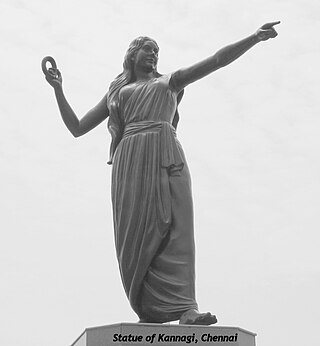
Kannagi, sometimes spelled Kannaki, is a legendary Tamil woman who forms the central character of the Tamil epic Cilappatikaram. Kannagi is described as a chaste woman who stays with her husband despite his adultery, their attempt to rebuild their marriage after her unrepentant husband had lost everything, how he is framed then punished without the due checks and processes of justice. Kannagi proves and protests the injustice, then curses the king and city of Madurai leading to the death of the unjust Pandyan King of Madurai, who had wrongfully put her husband Kovalan to death. The society that had made her suffer, suffers in retribution as the city Madurai is burnt to the ground because of her curse. In Tamil folklore, Kannagi has been deified as the symbol – sometimes as goddess – of chastity, with sculptures or reliefs in Hindu temples iconographically reminding the visitor of her breaking her anklet or tearing her bleeding breast and throwing it at the city.

Cilappatikāram, also referred to as Silappathikaram or Silappatikaram, is the earliest Tamil epic. It is a poem of 5,730 lines in almost entirely akaval (aciriyam) meter. The epic is a tragic love story of an ordinary couple, Kannaki and her husband Kovalan. The Cilappatikaram has more ancient roots in the Tamil bardic tradition, as Kannaki and other characters of the story are mentioned or alluded to in the Sangam literature such as in the Naṟṟiṇai and later texts such as the Kovalam Katai. It is attributed to a prince-turned-monk Iḷaṅkō Aṭikaḷ, and was probably composed in the 5th or 6th century CE.

The Five Great Epics are five Tamil epics according to later Tamil literary tradition. They are Silappatikāram, Manimekalai, Cīvaka Cintāmaṇi, Valayapathi and Kundalakesi.
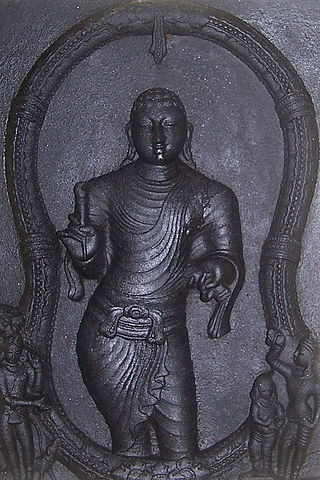
Ilango Adigal was a monk and a poet, sometimes identified as a Chera prince. He is traditionally credited as the author of Cilappatikaram, one of the Five Great Epics of Ancient Tamil literature. He is one of the greatest poets from Cheranadu. In a patikam (prologue) to the epic poem, he identifies himself as the brother of a famous Chera king Ceṅkuṭṭuvan (Senguttuvan). This Chera king, as stated by Elizabeth Rosen, ruled over his kingdom in late 2nd or early 3rd century CE. However, this is doubtful because a Sangam poem in Patiṟṟuppattu – the fifth ten – provides a biography of Ceṅkuṭṭuvan, his family and rule, but never mentions that he had a brother who became an ascetic or wrote one of the most cherished epics. This has led scholars to conclude that the legendary author Ilango Adikal myth was likely inserted later into the epic. In a 1968 note, Kamil Zvelebil suggested that, "this [Adigal claim] may be a bit of poetic fantasy, practised perhaps by a later member of the Chera Dynasty [5th or 6th century] recalling earlier events [2nd or 3rd century]".
Puhar is a town in the Mayiladuthurai district in the southern Indian state of Tamil Nadu. It was once a flourishing ancient port city known as Kaveri Poompattinam, which is described in Post Sangam literature like Silappadikaram, Manimekalai, Paṭṭiṉappālai and Akananuru as the capital of the Early Chola kings in Tamilakam. Puhar is located near the mouth of the Kaveri river, on the sea coast. It is mentioned in the Periplus of the Erythraean Sea.

Kovalan is a central character in Ilango Adigal's Silappatikaram, one of the ancient Tamil epics.
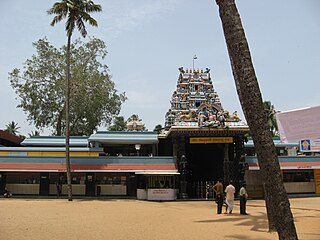
The Attukal Bhagavathy Temple is a Hindu shrine located at Attukal in Kerala, India. It is situated near the heart of the city, two kilometres away from the Padmanabhaswamy Temple, East Fort, in Thiruvananthapuram. The goddess of the temple is identified with Bhadrakali, mounted over a vetala. She is also identified with Kannagi, the heroine of Ilango Adigal's epic Cilappatikaram.
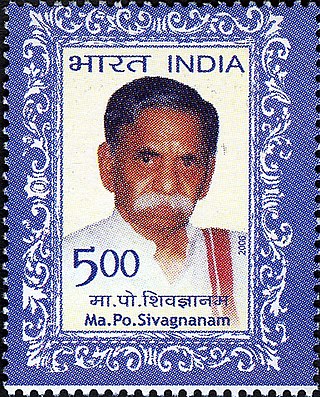
Mylai Ponnuswamy Sivagnanam, popularly known as Ma.Po.Si., was an Indian politician, freedom fighter, and the founder of the political party Tamil Arasu Kazhagam. He wrote more than 100 books.

Vattapalai is a suburban area in the Mullaitivu District of Northern Sri Lanka. Distinguished by its unique character, Vattapalai stands apart from the surrounding villages that were incorporated during the town's expansion. The name "Vattapalai" is rendered in Tamil as வற்றாப்பளை (Vaṟṟāppaḷai) and in Sinhala as වට්ටාප්පලෛ (vaṭṭāppalai).
Tondaiman Ilandiraiyan or Ilamtiraiyan was a ruler of Kanchipuram and a contemporary of the Early Chola king, Karikala. He is traditionally regarded as the founder of the Pallava dynasty. Ilandiraiyan is referred to in the literature of the Sangam period and is the hero of some of the poems in the Pathupattu. He was a poet himself and four of his songs are extant even today. He ruled from Tondaimandalam and was known as 'Tondaman'. According to historian S. Krishnaswami Aiyengar, the Pallavas were natives of Tondaimandalam and the name Pallava is identical with the word Tondaiyar.
Maṇimēkalai, also spelled Manimekhalai or Manimekalai, is a Tamil-Buddhist epic composed by Kulavāṇikaṉ Seethalai Sataṉar probably somewhere between the 2nd century to the 6th century. It is an "anti-love story", a sequel to the "love story" in the earliest Tamil epic Cilappatikaram, with some characters from it and their next generation. The epic consists of 4,861 lines in akaval meter, arranged in 30 cantos.
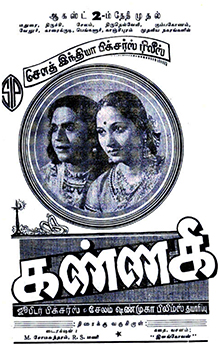
Kannagi is a 1942 Indian Tamil-language epic film directed by R.S Mani based on one of The Five Great Epics of Tamil Literature, Cilappatikaram. This is the first Tamil film based on the epic. The second film, Poompuhar, was released later in 1964.

Poompuhar is a 1964 Indian Tamil-language epic film directed by P. Neelakantan and written by M. Karunanidhi. It is the second film based on the epic Cilappatikaram after Kannagi (1942). The film stars S. S. Rajendran, C. R. Vijayakumari, Rajasree and K. B. Sundarambal. It was released on 18 September 1964.
Kodungallooramma is a 1968 Indian Malayalam-language film, directed and produced by Kunchacko. The film stars Prem Nazir, K. R. Vijaya, Adoor Bhasi and Thikkurissy Sukumaran Nair. It was based on the Tamil poem Chilappathikaram by Ilango Adigal and also tells the story of Kodungallur Bhagavathy Temple, where the leading deity is also considered as Kannaki, the heroine of Chilappathikaram. The film had musical score by K. Raghavan.
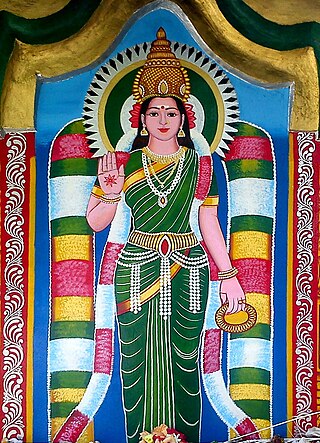
Kannaki Amman is the deified form of Kannagi, the heroine of the Tamil epic Cilappatikāram. She is primarily worshipped in Sri Lanka and Kerala, and in a minor way in few parts of Tamil Nadu. As a goddess of chastity, she is venerated by Indian Tamils and Malayalis, Sri Lankan Tamil Shaivites, and also by the Sinhalese Buddhists as Pattini Amma. In regional Hindu tradition, her tale is interpreted as the story of Durga demanding justice after the death of her husband, Kovalan, who is identified as a form of Shiva.
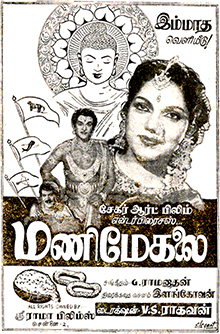
Manimekalai is a 1959 Indian Tamil-language epic film directed by V. S. Raghavan and written by Elangovan, starring T. R. Mahalingam and P. Bhanumathi. It is based on the epic of the same name by Chithalai Chathanar.

Paththini (පත්තිනි) is a 2016 Sri Lankan Sinhala-language epic-drama film written and directed by Sunil Ariyarathna and produced by Dr. Milina Sumathipala, co-produced by Jagath Sumathipala and Thilanga Sumathipala on behalf of Sumathi Films. The film features Pooja Umashankar in the title role, Uddika Premarathna in the lead role while Ravindra Randeniya, Lucky Dias, Veena Jayakody, and Aruni Rajapaksha appear in supporting roles. The film is based on the Tamil epic Silappatikaram, written by Ilango Adigal. The film was released on 5 May 2016 in the film halls of the EAP Circuit.
The Changattu Bhagavathy Temple is a Hindu religious shrine at Kallambalam in Kerala, India. The Goddess Kannaki (Parvathi) is the main deity in this temple.
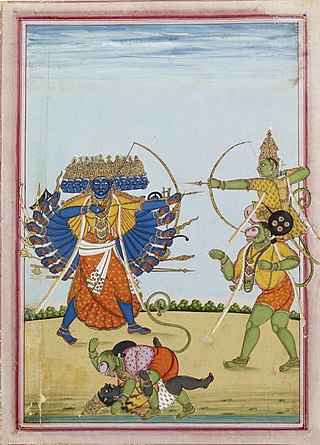
Ramayana is one of the ancient Indian epics. According to Robert P. Goldman, the oldest parts of the Ramayana date to the mid-8th century BCE. The story is narrated by the saint poet Valmiki and tells the tale of Prince Rama of the city of Ayodhya, who is banished into the forest, accompanied by his wife Sita and half-brother Lakshmana. During the exile, Sita gets kidnapped by the king Ravana of Lanka, and Rama, with the help of a vanara army, rescues Sita from Lanka. The original set in Sanskrit consists of 24,000 verses, and there are several variations in the story narrated in South Asian and South East Asian cultures, across the Indian subcontinent, Thailand and Indonesia, with several versions re-written in various Indian and other Asian languages.
Manimekalai is a Tamil epic composed by Sithalai Sattanar.














